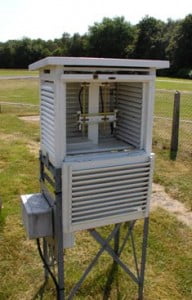Make a box for your thermometer
Thermometers are kept in special boxes (Stevenson screen) to protect them from sunshine, wind and the surroundings. You can make your own special box.
What you will need:
A sturdy plastic or wooden box that can stand on its side
White paint
A thermometer
Blu-Tack (or similar)
What to do:
- Paint the outside of your box white and wait until it’s dry.
- Stick the thermometer inside the box using Blu-Tack.
- Take the box outside and find a safe, shady place to keep it.
- Stand the box on its side so that the thermometer is at the back of the box and protected from direct weather conditions.
- Now you can take temperature readings at the same time every day.
Stevenson screen
Web page reproduced with the kind permission of the Met Office
Borrow an Instrument
Did you know the Royal Meteorological Society lends instruments to schools free of charge?


